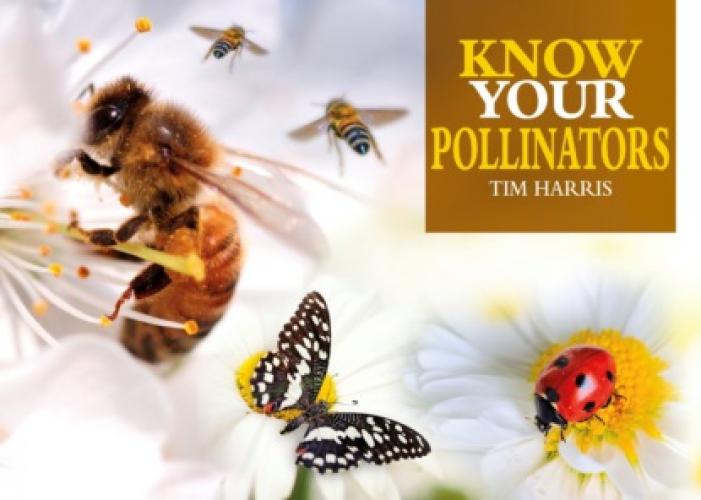Monarch butterfly (Danaus plexippus) on thistle.
Foreword
The primary way in which plants create new generations is by producing seeds containing all the genetic information necessary to grow a new plant. Seeds are made when pollen is transferred from the stamen of one plant to the stigma of another, fertilizing it. This may be done by the wind, by water, or by animals. The animals responsible for this incredibly important transfer are called pollinators. They include bats and hummingbirds, but it is the insect pollinators that are the subject of this book: bees, butterflies, moths, hoverflies, and beetles. As well as being real heroes of the natural world, all are beautiful in their own way, and many can be attracted to your garden or backyard.
BEES AND WASPS
Buff-tailed bumblebee (Bombus terrestris) covered with pollen.
Bees are pollinators par excellence. More than 20,000 different kinds are known. Most visit flowers to suck up energy-giving nectar. Pollen—essential for the raising of young—attaches to a bee’s body as it moves from plant to plant. Some are more efficient pollen collectors than others. For example, hairy bumblebees have pollen-gathering “brushes” on various parts of their bodies. In moving from plant to plant, bees transfer pollen from the stamen of one flower to the stigma of the next, enabling pollination. Most of the pollen is taken back to the colony or the nest burrow to feed young bees.
The range of bee lifestyles is truly bewildering. In social species such as honeybees, female “workers” perform most of a colony’s important functions. There is a clear differentiation between breeding queens, nonbreeding workers, and male drones. The workers make honey from nectar, pollen, and enzymes produced in their stomach, and this provides food during the winter, when nectar and pollen are unavailable.
Most bees are solitary, however, with a single female establishing a nest and laying eggs. And still more bees are kleptoparasites, breaking into the nests of other bees to lay their own eggs inside. Closely related, wasps are predatory insects but since they also visit flowers, they are pollinators too.
1 Buff-tailed Bumblebee
Bombus terrestris
Characteristics
Length: Queen 0.71 in (18 mm); worker and male 0.51–0.55 in (13–14 mm).
Flight season: May–October.
Nectar sources: Very varied.
Habitat: Meadows, farmland, parks, gardens.
The large, furry, European bumblebee is a familiar sight as it forages on garden flowers. It can be identified by two orange “collars” on a black background, one near the neck and one on the abdomen. The tip of the abdomen is buff in queens and males, but whitish in workers.
After emerging from hibernation in spring, a queen will start foraging busily on flowers such as sallows, plums, cherries, and gorse—and she will pick an underground site for a new colony, often an old mouse nest. Once settled, she lays eggs, which hatch into larvae. When it reaches its peak, there may be more than 500 bees in a colony, most of them workers (all females), which perform most of its important functions: foraging for food at flowers as varied as knapweeds, daisies, lavender, deadnettles, and ivy, according to the season. The workers also defend the nest from attackers and care for the larvae. Male bees, or drones, hatch from unfertilized eggs; they leave the colony when they reach adulthood to go in search of a mate, their only function.
2 Eastern Bumblebee
Bombus impatiens
Characteristics
Length: Queen 0.67–0.82 in (17–21 mm); worker and male 0.39–0.67 in (10–17 mm).
Flight season: April–November.
Nectar sources: Very varied.
Habitat: Forest, farmland, parks, gardens.
This is one of North America’s most important pollinators. Abundant in the east, it is now used for greenhouse pollination in California and Mexico, far outside its natural range. It is a social insect. Workers fly from flower to flower to collect pollen; goldenrods are particularly popular nectar sources, along with thistles, apples, clovers, vetches, burdocks, rhododendrons, and tomatoes. Some pollen becomes attached to the bees’ hairy bodies and some is collected in “pollen baskets” on the legs. The workers take it back to the underground nest, which typically houses 300–500 bees.
Eastern bumblebees are mostly covered in black hairs, with a band of yellow on the thorax and another on the first segment of the abdomen. Queens emerge from hibernation in March or April and fly in search of sites for new colonies, which are typically established in May. Each queen lays around 2,000 eggs in a season, about half of them surviving to adulthood. Female workers emerge in June, then the males and new queens appear in August and September. In late fall, the old queen and the workers die, as do the males, although not before mating with the next generation of queens.
3 Brown-belted Bumblebee
Bombus griseocollis
Characteristics
Length: Queen 0.82–0.90 in (21–23 mm); worker and male 0.39–0.75 in (10–19 mm).
Flight season: April–September.
Nectar sources: Very varied.
Habitat: Meadows, farmland, parks, gardens.
A frequent visitor to coneflowers, milkweeds, clovers, vetches, peas, and beans, the North American brown-belted bumblebee is a generalist forager. Common east of the Rockies, its range also extends to Oregon and northern California. It can thrive anywhere there are flowers—even in the middle of the largest cities. A male was once seen 102 floors up on the Empire State Building in New York. The brownbelted bumblebee emerges later and becomes inactive later in the year than its eastern bumblebee counterpart. Its head and thorax are mostly black, with some yellow hairs, and the abdomen is yellow, banded black.
